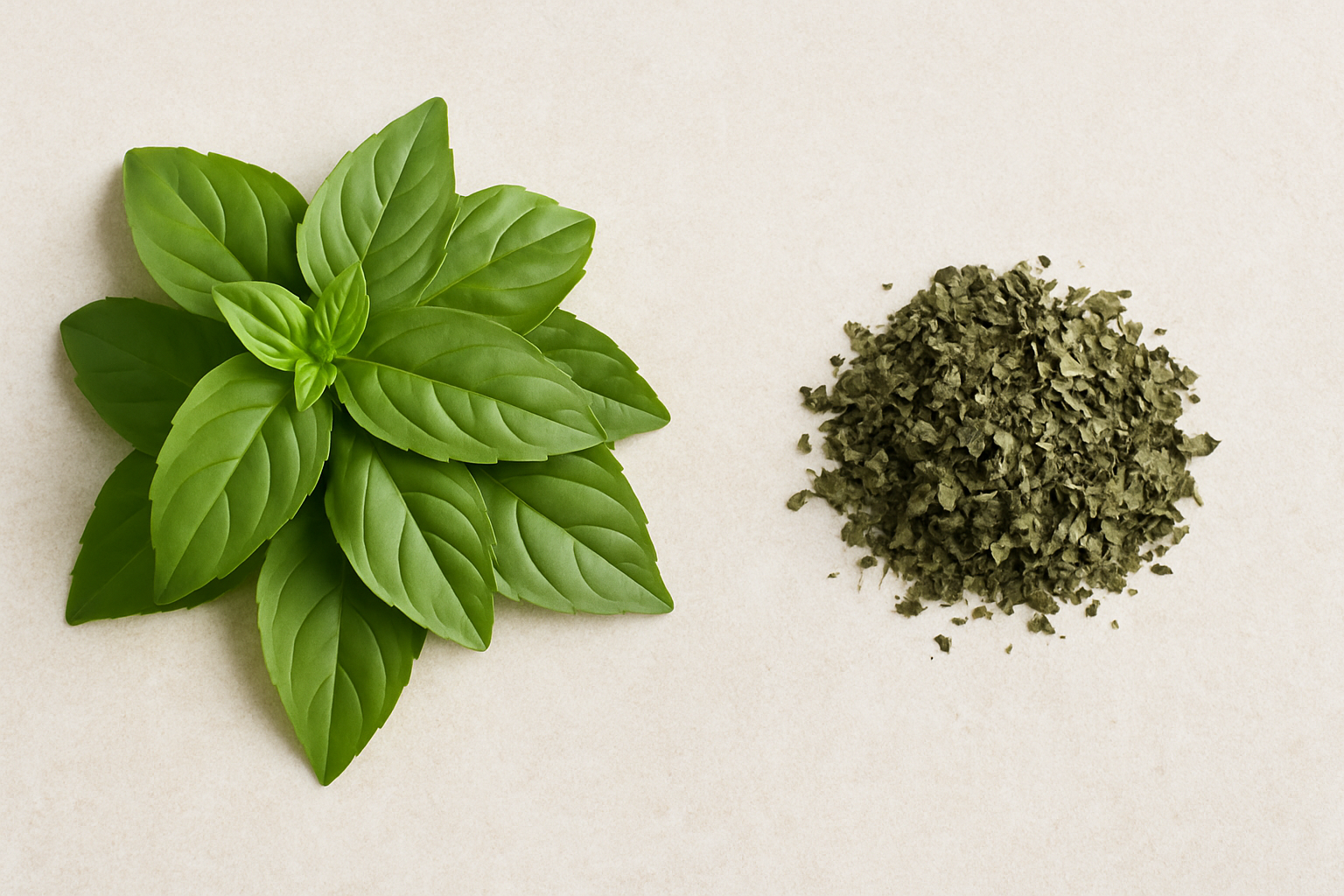Dried Basil: The Ultimate Guide to Using and Preserving the Herb

Dried Basil: Your Pantry's Secret Weapon for Year-Round Flavor
That summertime bounty of fresh basil doesn't have to be a distant memory in the middle of winter. While nothing truly replicates the bright, peppery punch of a just-picked leaf, dried basil is a formidable and essential staple for any well-stocked kitchen. When used correctly, it offers a depth of flavor that can elevate dishes in its own unique way.
This guide unlocks the secrets of dried basil leaves: when to use them, how to store them for maximum potency, and the simple math to seamlessly convert between fresh basil to dried in any recipe.
Why Keep Dried Basil in Your Pantry?
Dried basil isn't just a lesser substitute; it's a different ingredient with its own purpose. Here’s why it deserves a spot in your spice rack:
- Shelf-Stable Convenience: It's available year-round, providing a reliable basil flavor whenever the craving strikes, regardless of the season.
- Concentrated Flavor: The drying process concentrates the essential oils, creating a more potent, albeit different, flavor profile. This makes it ideal for long-cooking dishes where it has time to rehydrate and infuse its essence.
- Economic and Practical: A single jar of dried basil goes a long way. It’s a cost-effective way to add herbaceous flavor without worrying about a fresh bunch wilting before you can use it all.
The Golden Rule: When to Use Dried vs. Fresh Basil
This is the most important lesson in mastering this herb. Using the right form at the right time makes all the difference.
✅ Use Dried Basil In:
- Long-Simmering Dishes: Soups, stews, braises, sauces (like marinara or Bolognese), and slow-cooker recipes. The extended cooking time allows the hardened leaves to soften and release their deep, earthy, and slightly minty flavor into the entire dish.
- Dry Rubs and Spice Blends: Its powdered form mixes perfectly into rubs for meats, seasoning salts, and homemade spice mixes.
- Bread Doughs and Savory Baked Goods: Incorporated directly into the dough, it distributes flavor evenly.
❌ Avoid Using Dried Basil In:
- Fresh Applications: Never use dried basil as a garnish. It will feel like gritty, tasteless dust on top of your finished dish.
- Quick-Cook Recipes: Salads, fresh pesto (it will be a tragedy!), cold dips, or dishes that are cooked for only a few minutes. The dried leaves won't have time to rehydrate and will taste like hay.
- When Fresh is the Star: In a caprese salad or any dish where basil is a primary, fresh flavor, there is no substitute.

The Art of Conversion: Fresh to Dried and Vice Versa
Since dried basil is more concentrated, you can't swap it 1:1 with fresh. Follow this simple ratio:
The Standard Conversion:
1 tablespoon of fresh basil = 1 teaspoon of dried basil
In other words, you need three times the amount of fresh basil to match the volume of dried. However, because the flavor profiles are different, think of this as a guideline for quantity, not an exact flavor match.
- Converting
fresh basil to dried basil: If a recipe calls for 3 tbsp fresh, use 1 tbsp dried. - Converting
dried basil to fresh basil: If a recipe calls for 1 tsp dried, you should use 1 tbsp fresh. (Note: only do this if the dish is appropriate for fresh herbs!).
How to Store Dried Basil for Maximum Flavor
The enemies of dried basil leaves are light, heat, air, and moisture. To preserve its color and aroma:
- Airtight Container: Always keep it in a sealed glass jar or a container with a tight-fitting lid.
- Cool, Dark Place: Store it in a pantry or cupboard, away from the stove or any heat source.
- Buy Whole Leaves if Possible: Dried basil leaves that are still somewhat whole retain their essential oils longer than pre-ground powder. Crush them between your fingers just before using to unleash their full aroma.
- Check Freshness: Dried herbs don't spoil, but they do lose potency. They are at their best for about 6-12 months. Give them a sniff—if they barely smell like anything, it’s time to replace them.
Dried Thai Basil: A Secret Weapon for Asian Cuisine
Dried Thai Basil holds a special place in the pantry for enthusiasts of Southeast Asian cuisine. While its flavor is distinct from the more common sweet basil - offering a stronger, more robust anise and licorice note with a subtle peppery kick—it becomes an indispensable ingredient when fresh is unavailable.
The drying process intensifies its earthy undertones, making it ideal for long-simmering dishes like curries, soups, and stir-fries, where it slowly rehydrates and infuses the entire dish with its complex aroma. Unlike delicate sweet basil, dried Thai basil’s bold character stands up well to heat, adding depth to spice blends, marinades, and even homemade curry pastes.
However, it’s not a direct garnish substitute for fresh Thai basil, as it lacks the same bright, immediate fragrance. Properly stored in an airtight container away from light, it remains a reliable flavor backbone for achieving authentic Asian-inspired flavors year-round.
Does Dried Basil Offer Health Benefits?
Yes! While some volatile oils and vitamin C are reduced during drying, the concentrated antioxidants and compounds like vitamin K, iron, and calcium remain. Dried basil still contributes to your health, offering anti-inflammatory and antioxidant properties, making it a healthy addition to your cooking year-round.
Conclusion: Embrace the Power of the Pantry
Dried basil is not a compromise; it's a strategic tool. It provides a warm, earthy, and robust basil essence that forms the foundation of countless cooked dishes. By understanding its strengths—and its limitations—you can wield both fresh and dried basil with confidence, ensuring delicious, herb-infused meals no matter what the calendar says.
